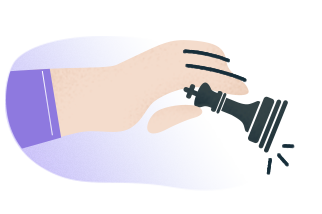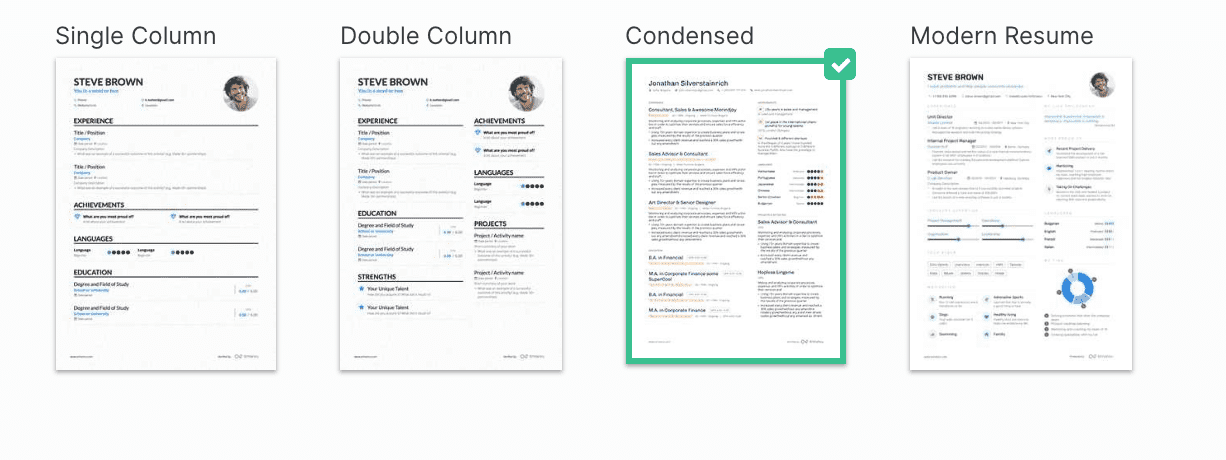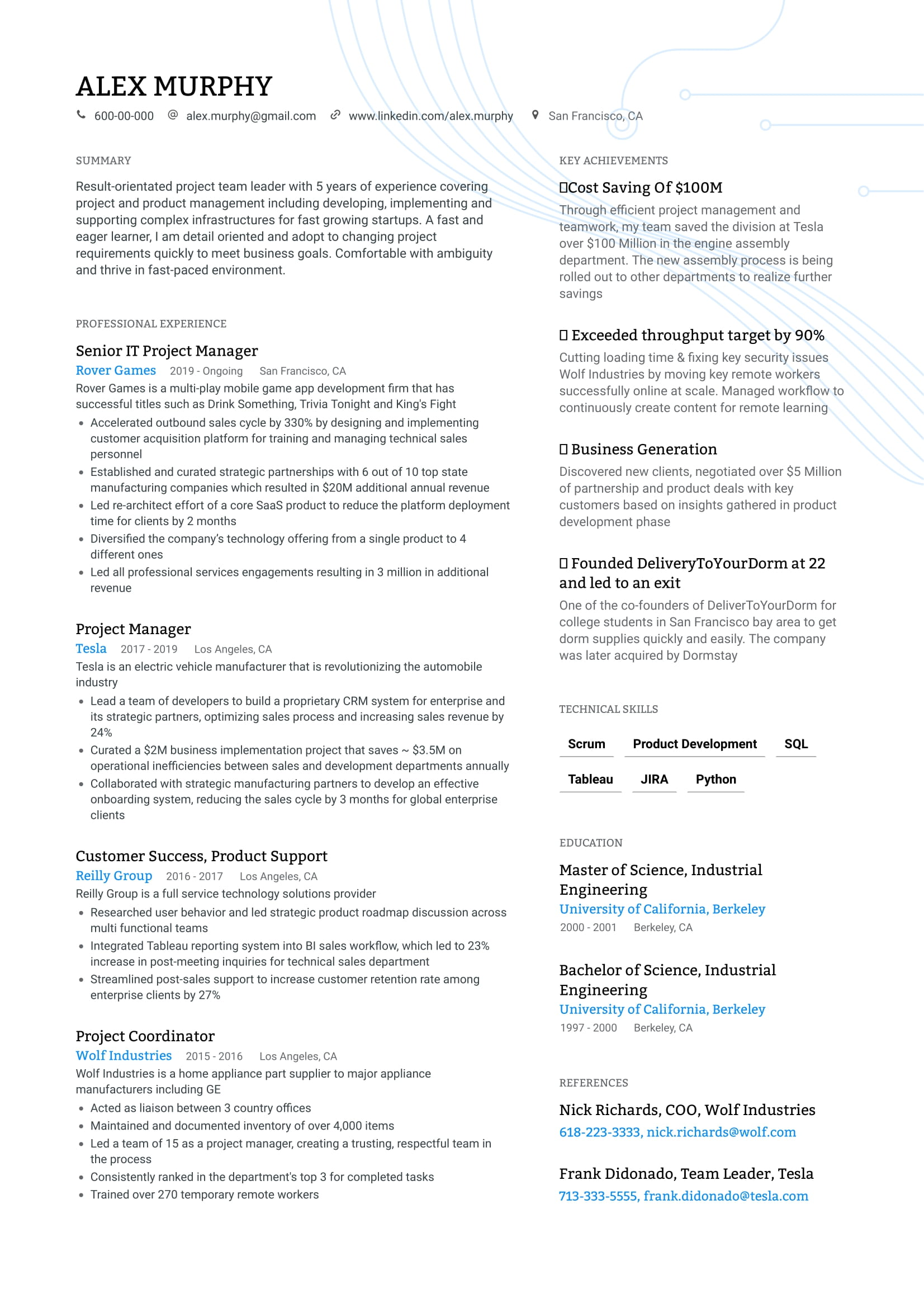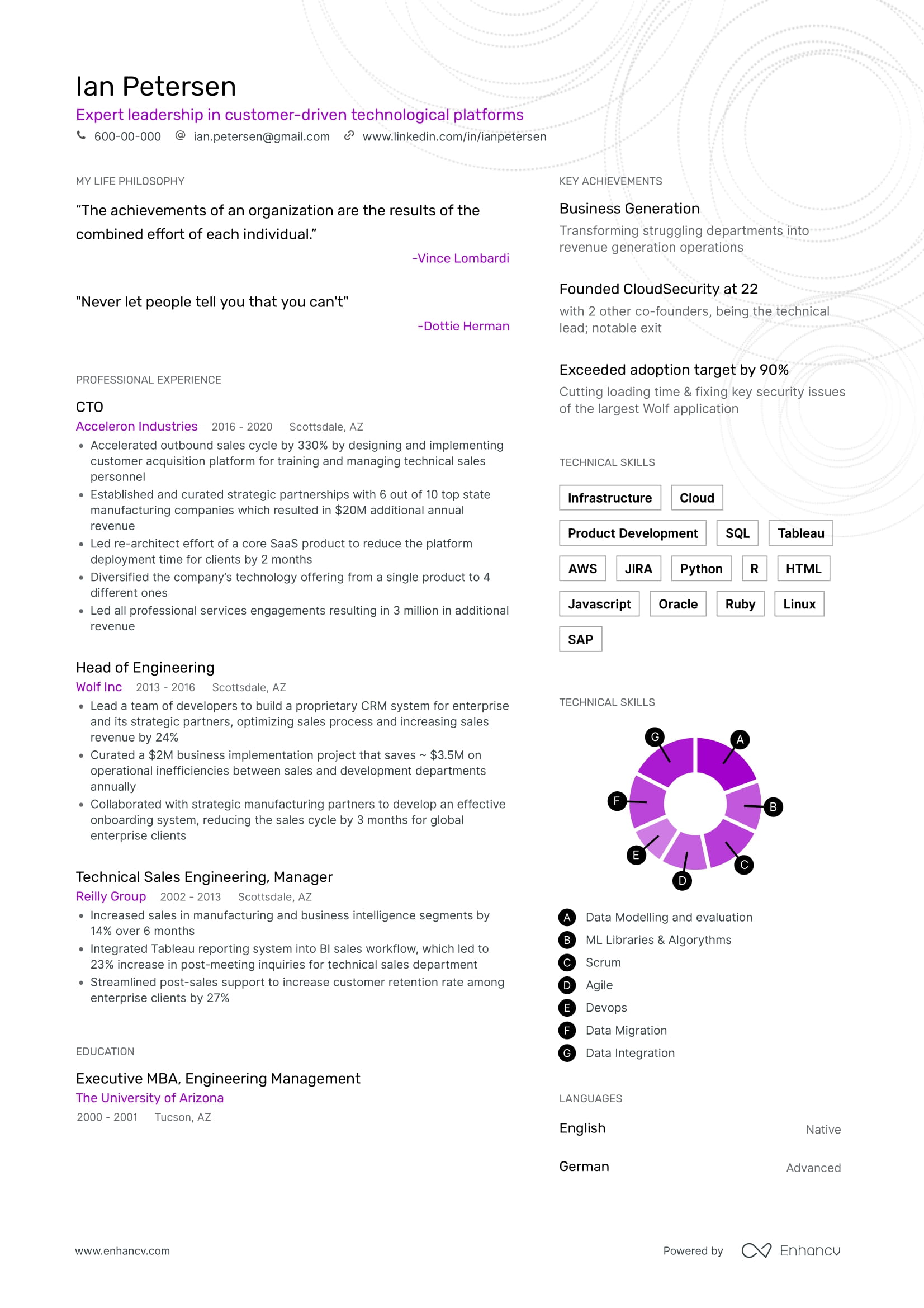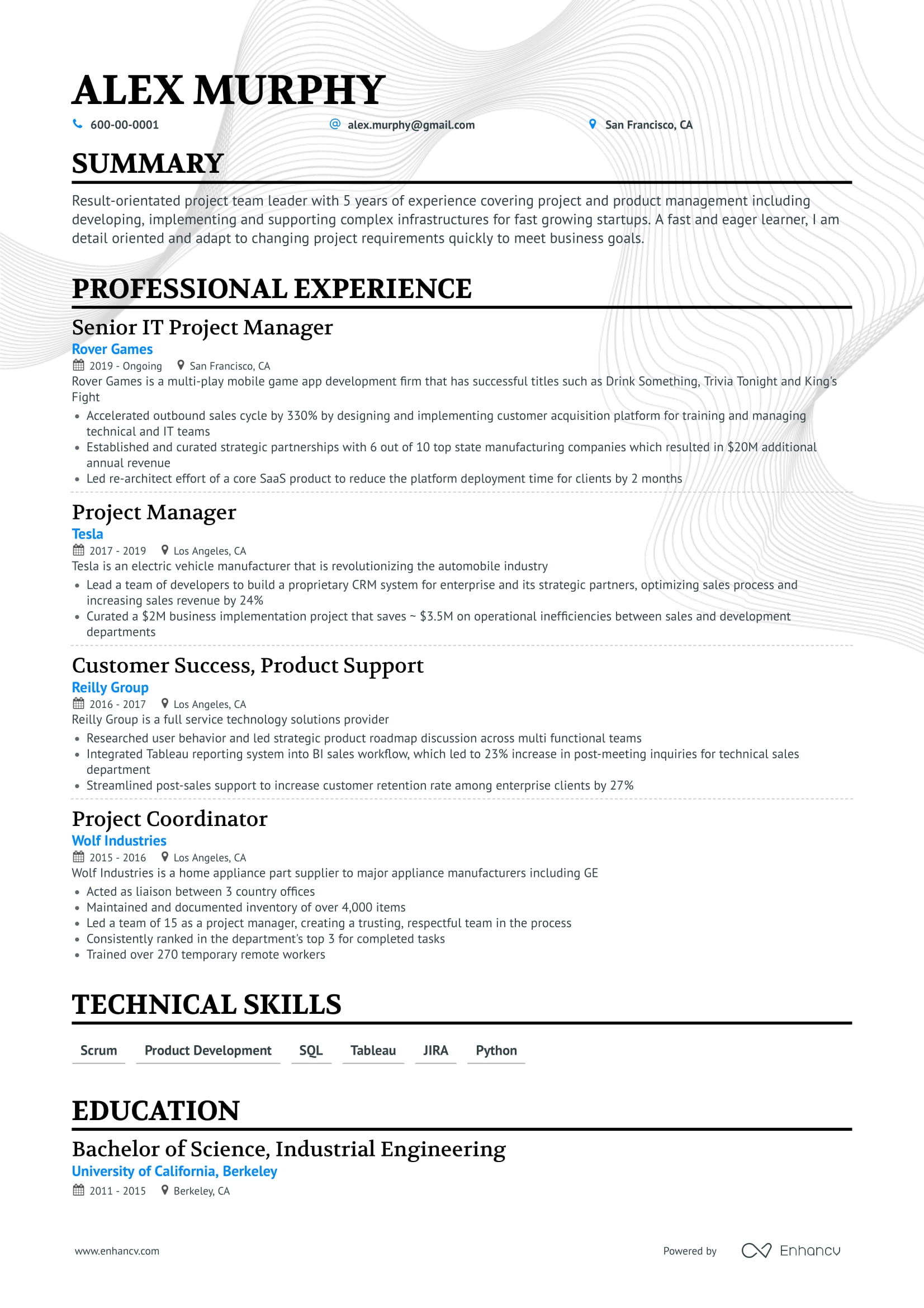Example Marketing Resume - Browse more resume templates and build a stand-out resume
Marketing resumes face the dual challenge of showing passion and creativity alongside hard numbers to demonstrate impact. Simultaneously demonstrating that you’re comfortable in both worlds of marketing requires a carefully crafted resume.
The potential upside, however, is enormous. Getting this combination right can mean getting the interview, nailing it, and ending up with the marketing role you’ve been dreaming of.
That’s why this guide is designed to answer every question you might have about how to get your marketing resume just right.
What does a winning marketing resume look like?
Try one of our 10 other marketing resume examples:
- Marketing internship resume examples
- Marketing manager resume examples
- eCommerce marketing resume examples
- Growth marketing resume examples
- Content marketing resume examples
- Social media specialist resume examples
- Brand Manager resume examples
- SEO resume examples
- Digital marketing manager resume examples
This guide will teach you everything you need to know about crafting the perfect marketing resume:
✔ How to plan out your marketing resume to make the whole process easier.
✔ What to look for in the ideal marketing resume template.
✔ How to craft a simple but powerful resume header.
✔ Why your marketing resume needs an objective or summary.
✔ How to frame your education and experience sections around results (and why it matters).
✔ The secret formula to showing the exact skills and certifications to get hired.
How to write a marketing resume
- Focus on the right metrics.
In marketing, there are many metrics. Most metrics are ordinary and show you as a generic task performer. But some will land you an interview.
Bad example: hired 4 marketers to extend marketing department
Good example: launched a DataOps department that reduced time to customer insights by 600%
- Demonstrate your ability to scale results.
Generating 10 sales and generating 1000 sales requires two completely different mindsets and skillsets. Make sure your marketing resume shows your potential to take on more challenging tasks.
Bad example: got a company blog featured in a top business publication
Good example: designed launched a digital PR campaign that landed over hundreds of features in top-20 US business publications
- Use resume format and layout to guide the recruiter’s attention to your strengths
Make sure your resume is easy to scan by combining headers, bullet points, andcustom sections. Usebold text to emphasize your results. Control recruiters' attention with white space andcolor.
If you’ve been working in marketing for years, a classicreverse-chronological resume works best. Experience is an excellent indication that you are qualified, so highlight this part of your resume.
If, however, you have a mix of formal and informal marketing experience, ahybrid resume might work better. When you use hybrid formats, your skills and work experience are both highlighted.
Every marketer knows how to plan out a strategy, and creating a marketing resume is no different. Consider what sections and information you’d like to include before you start. Here are some suggestions:
The top sections to include on a marketing resume
- Objective or Summary
- Marketing Experience
- Education
- Soft Skills
- Technical skills
- Certifications
- Interests
We’ll walk you through how to create each one below. What matters is starting with a plan and a goal!
How to Choose a Marketing Resume Template That Works
You don’t have to be a CMO to know that visual elements speak volumes when it comes to marketing. Your resume is no different.
That’s why choosing the layout that fits your content and sends the right visual message is key.
- Basic template - If you’re applying to be a marketing intern and don’t have much experience, this layout works best. It doesn’t take as much content to fill it up and make it look impressive.
- Professional template - This is the standard marketingresume layout we recommend for most mid-level professionals. It balances your content with enough space to create a pleasant visual style that doesn’t overwhelm the reader.
- Simple template - For marketing managers or CMOs, your resume is going to be more on the dense side: you’ve got a lot to show. This layout is designed exactly for that. It fits more onto the page without making it difficult to read.
- Creative template - Applying to a hyper-creative marketing firm or a world-changing startup? Ourcreative layout is bright, airy, and modern. At a glance, it shows that you’re on the cutting edge and have plenty of confidence in your abilities.
Here are a few other things to consider when choosing a marketing resume template:
- Consider how to structure your content so the most important elements (the ones that will make you stand out to the reader) are right upfront.
- Keep the length in check, while someone looking to hire a senior marketer will probably read a few pages, lower-level positions should keep things short and to the point.
- Add some color but don’t overdo it. A resume that’s not all black and white will be more visually pleasing, but going too far in that direction can have the opposite effect. A tactic to consider is using the color scheme of the company you’re applying to (it’s a nice touch).
The power of a great marketing resume header
You’re a marketer, so you know how powerful just a few words can be.
Your resume header is where you can strategically add a few keywords to create a powerful first impression.
Have a look at these examples to see what we mean:
Notice the difference? It’s the same person with the same experience, but how they present themselves makes an enormous difference.
The first example is… well, “blah”. You don’t detect any passion, confidence, anything really.
The second example, on the other hand, exudes pride in their work and confidence in their skills. That’s exactly the kind of first impression you want your marketing resume header to make.
How to write a marketing resume objective or summary
Every good marketing resume should have an objective or summary. The reason is that they answer two critical questions for anyone reading your resume: who are you and what are you trying to achieve?
There are two ways to do this. One is to include a short statement under your name in your resume header. The idea here is to quickly and efficiently explain a bit about who you are. This helps give context to the rest of your resume.
But for most marketers, a summary is the better way to go. It gives you a little more space to explain who you are and make a strong impression.
Here’s what your summary section shouldn’t look like:
The problem with that summary can be summarized in one word: vague. What does your expertise look like? How many years have you been a digital marketer? Do you have any certifications? What interests you in digital marketing? What kind of skills do you want to grow?
I could go on.
Now compare that to a better version of the same summary below.
The difference is stark.
This version reads like a summary of a person on a mission with confidence and enthusiasm, brimming with ideas. Yet, it still manages to include some important specifics.
Sure, that information will be contained elsewhere in the resume as well, but your summary is your one shot to make a strong impression by telling a cohesive story, don’t blow it.
Check out more examples of interview-winning Summary sections in ourResume Summary: How-To Guide with 30+ Examples You Need To See article.
What should a marketing resume’s work experience section look like?
Your marketing resume’s experience section needs to be laser-focused on results. No company wants to hire someone to “manage social media profiles” or “oversee PPC”, they want someone who can boost social media engagement or decrease CPC by 40%.
Look at the difference between these two marketing resume experience examples:
They describe the exact same experience, but by being specific, using numbers, and framing the experience around goals that are relevant to the employer the first example is 100% more effective.
You can also try mentioning instances when you learned a new marketing skill or identified an area for improvement. Showing that you’re self motivated is another big draw for most companies looking to hire entry level marketers or even VPs of marketing.
What should be included in an entry level marketing resume?
If you’re looking for a marketing internship or your first marketing job, crafting a resume that shows you’re qualified is extra challenging. Fortunately, there are plenty of other ways to demonstrate you have the skills and qualities necessary to thrive in a marketing position.
In this example, a marketing intern demonstrates self-motivation, organizational abilities, and the ability to work well in groups. All of these skills are exceptionally valuable in a marketing position and none of them required a job in marketing to demonstrate.
Without even mentioning marketing, these skills and examples show that this person has what it takes to get started in an entry level marketing position.
Check out our excellent samples of Experience resume sections in our template-richExperience Resume Section guide.
What’s the best way to add your education to a marketing resume?
If you have a marketing degree, this is fairly straightforward. Emphasize the skills you gained, internships you had, etc. If your degree was more than 5 or so years in the past, you can leave off most of the detail.
However, many marketers have degrees in totally unrelated fields, so should they be included?
Yes, but be sure to frame them towards marketing if possible. Here’s an example of someone with a history degree applying for a marketing position:
This education section manages to show plenty of marketing relevant skills:
- The ability to write and research (particularly on a deadline)
- An understanding of how advertising works and its history
- Public speaking and presentation skills
- Organization and leadership
And all without a marketing degree or certification.
What keywords and marketing resume skills make the difference?
In general, the skills on your resume should match what the job description is asking for as closely as possible (more on how to do that below). But how should you show your skills?
First, don’t just list them. Simply stating that you’re “hard working” or good with “Google Analytics” doesn’t mean very much. As much as possible, make sure you include examples and/or real examples which demonstrate your skills.
But that doesn’t mean you don’t need to label them. Most bigger companies use Applicant Tracking Systems (ATS). These scan resumes for set keywords, so channel your inner SEO writer and make sure they’re in there.
Now which skills should you consider?
8 marketing technical skills to include on your resume
- HTML5
- SQL if you’re dealing with databases
- Front-end development
- A strong grasp of statistics
- Page design
- Data modeling
- Email automation platforms like Mailchimp
- Zapier (because what can’t a marketer do with it?)
For hard skills, certification, educational experience, or an example of you getting results by applying the skill should suffice.
8 marketing soft skills every marketer needs
- Adaptability
- Self-motivation
- Creativity
- Organization
- Working well in teams
- Patience and tenacity (especially for SEO)
- Curiosity
- Empathy
Showing you have a soft skill is certainly trickier. A dedicated section in which you list your soft skills and include an example of when you demonstrated that skill is the most effective technique.
Our technique for perfecting matching a marketing resume to the job description
The skills you present on your marketing resume should always be based on the job description. Here’s a section taken from a real marketing job description as an example:
“Core duties include producing, implementing, and tracking campaignsneeded to achieve company sales goalsand engaging with customers. Others include updating databasewith contact information, researching and compiling mailing lists, and assisting with monthly reports.”
Based on this, you can see you’ll need the following skills:
- Experience with every stage of creating and implementing marketing campaigns.
- A track record of hitting set goals.
- Customer service experience.
- Knowledge of how to work with databases and SQL.
- Familiarity with a program like Mailchimp and email marketing experience.
- Writing and presentation skills to show you can put together monthly reports that won’t put anyone to sleep.
How should you list your certifications on a marketing resume?
In most marketing positions, being certified in areas like Hubspot or Google Analytics is important. It shows that you have a grasp of the most important elements of those fundamental tools. But where should these certifications go on your marketing resume?
It depends. If you have just one or two certifications, you can include them in your resume header. If you have more, it makes sense to dedicate a separate section to them.
The next question is, which marketing certifications should you include on your resume? Here’s a list of the 10 top ones to get you started.
Top 10 Marketing certifications to include on your resume
- Google Analytics Certification
- AMA Certified Professional Marketer
- Hootsuite Social Marketing Certification
- Google Ads Certification
- HubSpot Inbound Marketing Certification
- HubSpot Content Marketing Certification
- Digital Garage: Fundamentals of Digital Marketing Certification
- W3Schools certification in HTML5, CSS, JavaScript, jQuery, PHP, and XML
- Facebook BluePrint Certification
- YouTube Certification
Still, ultimately the most important certifications are the one the job description specifically asks for. If they want you to be familiar with Google Analytics, be sure that’s featured prominently.
Pin Your Application with a Stand-Out Marketing Cover Letter
In case the job description says you need to provide a cover letter, do include yours. Otherwise, you can always leave it out.
Nowadays, job application forms include questions like “why do you want to work here”, or “explain why you’re the best fit for us”, which makes you wonderare cover letters really necessary?
Still, they help youtell your story in a way that, if written right, it’s captivating and engaging.
In any case, you should pay close attention to the following tips when a cover letter is a must:
- Make sure you go over acover letter checklist, not to forgetwhat your cover letter should say;
- Match thecover letter design with your resume’s;
- Address your cover letter properly;
- Keep an eye on yourcover letter length;
- Use a propercover letter ending;
If you need more inspiration for a marketing cover letter, check out this link:Real Marketing Cover Letter Example.
In summary, what do you need to do to create an effective marketing resume?
There’s no denying that competition is fierce for marketing positions (I mean, you’re competing with fellow marketers). But you can stand above the competition by doing the following:
- Start by analyzing the job description and planning the resume sections you need
- Choose a marketing template that balances the amount of content on your resume with the appealing visuals.
- Write an objective or summary which tells a compelling story about who you are and what you hope to achieve.
- Include specific examples and numbers in your marketing experience to show you can get things done.
- Choose the skills and marketing certifications which match the job description (and give examples of how you’ve used them to achieve results).
